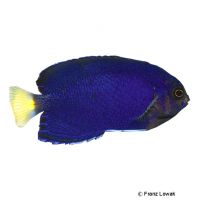Whitetail Angelfish (Centropyge fisheri)
| Whitetail Angelfish Centropyge fisheri | |
|---|---|
| Name | Whitetail Angelfish |
| Name Lat. | Centropyge fisheri |
| Family | Angelfishes |
| Family lat. | Pomacanthidae |
| Order | Surgeonfishes |
| Order lat. | Acanthuriformes |
| Origin | Indo-Pacific |
| Habitat | Coral reefs |
| Diet | Omnivore |
| pH | 8.1-8.4 |
| Hardness | 8-10 °KH |
| Behavior | Semi-aggressive |
| Keeping | Individual, pair |
| Reef Compatible | With caution |
| Care Level | Moderate |
| Life Span | N/A |
| Protection | No |
| Metric Units | |
| Size | 6 cm |
| Temperature | 24-28 °C |
| Salinity | 33-36 ‰ |
| Aquarium | ~ 250 l |
| US Units | |
| Size | 2.5" |
| Temperature | 75-82 °F |
| Salinity | 1.020-1.025 sg |
| Aquarium | ~ 65 gal |
Distribution and habitat
The range of Centropyge fisheri is the Indian and Pacific Oceans, from the east coast of Africa through Indonesia to the central Pacific, where they live mostly in groups on inner coral reefs to depths of 60m.
Maintenance
They need a well-structured aquarium with a reef structure that offers hiding, resting and covering possibilities, with living stones that they can graze on (sponges, algae, small crustaceans) and that act like a biological filter as well as sufficient swimming space. Only lime-rich, heavy metal-free sands, gravel or stones may be used as substrate.
Filters, skimmers and heaters are necessary to ensure water quality, as well as pumps to simulate tides, swells and bottom currents. Lighting must be appropriate for the species' day-night rhythm
| Salinity: 33-36 ‰ | pH value: 8.1-8.4 |
| Carbonate hardness: 8-10 °KH | Nitrate content: 2-8 mg/l |
| phosphate content: 0.01-0.1 mg/l | nitrite content: 0.0-0.05 mg/l |
For salinity, an average value should be aimed for, which may only vary slightly by +/- 0.5 ‰. Ammonia and ammonium must not be measurable. Special attention must be paid to constantly good water quality.
Diet
In nature, they feed mainly on algae and crustaceans. The change of feed does not always succeed without problems. The food supply should consist of a commercially available, vitamin-enriched frozen special food mix for angelfish or a combination of algae (e.g. spirulina, nori), chopped shrimp, crab and mussel meat with live and frozen food, such as mysis, krill, bosmids and artemia, as well as live cyclops, which also serve to keep them busy. It is recommended to feed small portions several times a day (3-5 times)
Regular and varied feeding promotes health and increases resistance.
Behaviour and compatibility
It is recommended to keep them in pairs. To avoid ranking fights, they should be placed in the aquarium at the same time, with one of the animals being significantly larger. The dominant, larger animal always develops into the male. They are territorial and can sometimes be aggressive towards other dwarf angelfish with similar coloration or body shape.
Sex dimorphism
They are protogynous hermaphrodites, meaning most males develop from functional females. Males have a blue fin fringe.
Reproduction and breeding
There are isolated reports of offspring in the aquarium.
Important
In its wide range there are blue and orange (Hawaii) color morphs.
As reef dwellers, they should not be kept in a fish-only aquarium. Individuals have a tendency to pluck corals. When kept in pairs, with sufficient activity (live rocks) and varied feeding, they can be maintained in challenging coral tanks without attacking the corals.
If different species are kept together, care should be taken to ensure that the fish match each other in terms of water quality and temperature requirements and social behavior, and that the setup meets the needs of all species kept together. New fish to be introduced must be acclimated slowly to the water in the aquarium
Further literature can be found in your pet store.
References
Text: Werner Knapp; Image: Franz Lowak
Source: KUITER, DEBELIUS (2007): Atlas der Meeresfische: Die Fische an den Küsten der Weltmeere, Kosmos Verlag; ENGELMANN (2005): Zootierhaltung - Tiere in menschlicher Obhut: Fische, Verlag Harri Deutsch; PATZNER & MOOSLEITNER (1999): Meerwasser Atlas Bd. 6, Mergus Verlag
- Gemäß § 21 Abs. 5 Tierschutzgesetz idgF
